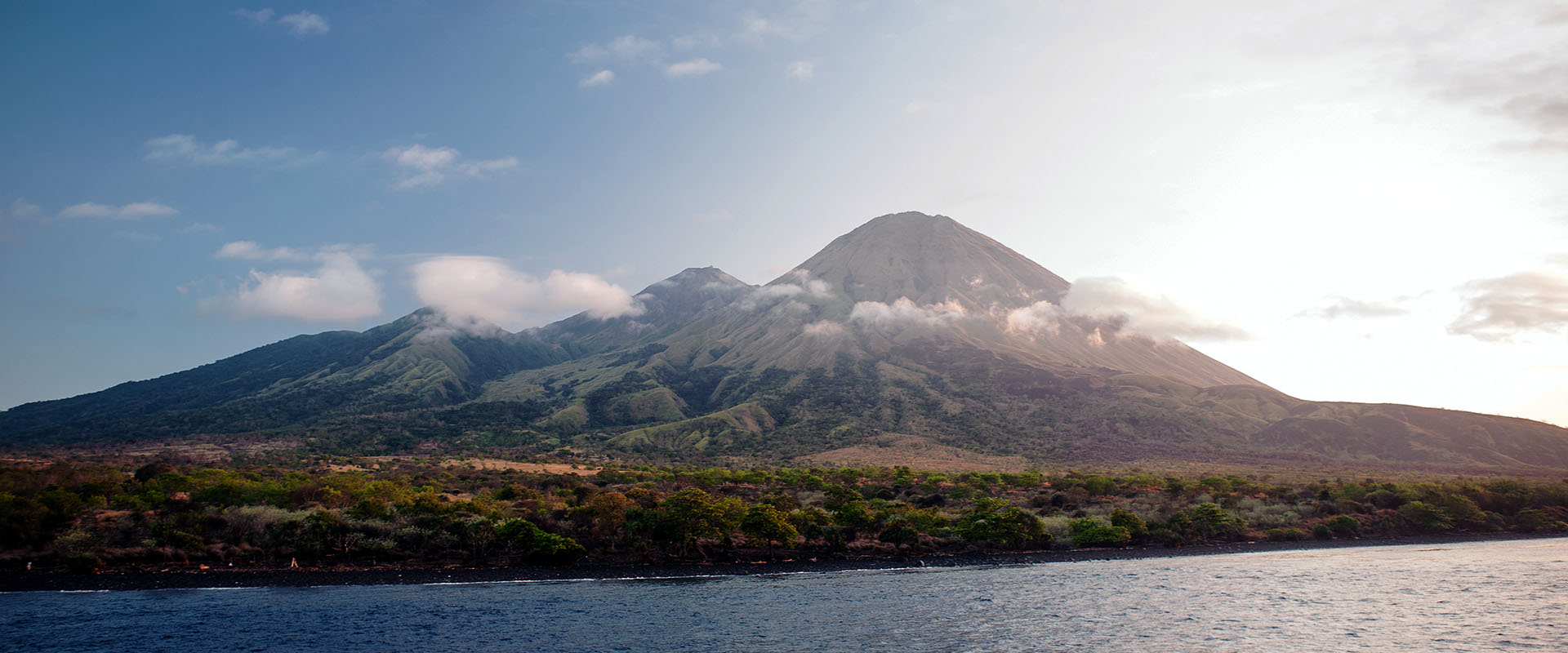Liveaboard Diving in Sangeang
What To Expect On A Sangeang Liveaboard
Liveaboards to Sangeang, to the northwest of Komodo Island in the direction of Bima, will transport divers to a special area for diving. Sangeang is a volcano towering over the surrounding Lesser Sunda Islands. Also known as Gunung Api, the volcano is still active, and since 2015, it has been smoldering with plumes of smoke visible from nearby islands. These smoky clouds and sloping green hills make Sangeang one of the region's most beautiful and atmospheric islands.
Although the island has been sparsely inhabited for many years, liveaboards still visit this area. It is home to only one tiny fishing village, likely due to the volcanic activity. Some local groups still farm the fertile ground around the volcanic cones. Most of these groups have been evacuated during several eruptions in recent years to avoid any casualties. The volcano has also been the cause of numerous ash clouds which have grounded flights around the area. A selection of Indonesian liveaboards offers dive itineraries to the Sangeang area.
Sangeang Underwater
The active nature of the volcano can be seen underwater, with beautiful topography and even hot rocks and sand on the bottom. Volcanic lava flow has created fantastic rock formations on the bottom and jet-black sands. Underwater vents from the volcano also mean divers aren’t the only ones causing bubbles. Endless air streams are coming through the sand around the island. Although this is an amazing diving experience, it is worth noting that it can sometimes cause the normally excellent visibility to be severely reduced.
The reefs are home to a huge variety of soft and hard corals and anemones, rich with colorful reef fish. The sight of beautiful fish amongst black corals and dark volcanic rock is quite stunning. There is also ample muck diving in the area, with hordes of critters on the reef and the bubbling sand. Lurid-colored flatworms are often seen down on the bottom, and pygmy seahorses and glowing flame file shells are this area’s ‘something special.’
Dive Sites Of Sangeang
Bubble Reef is probably the most famous of Sangeang’s dive sites. This is in no small part because it offers the opportunity to dive in the streams of bubbles coming from deep underground volcanic vents. The effect is spectacular, as is the number of fascinating critters, such as flatworms, seahorses, and ghost pipe fish. The site boasts sand and bubbles and a reef of hard, soft, and leather corals. Hot Rocks dive site also shares Bubble Reef’s level of volcanic activity. Here, the bubbles and heat from the sand and rocks make the water much warmer than at other dive sites. Hot Rocks also enjoys a beautiful reef full of gorgonians and critters, including nudibranchs and pygmy seahorses.
Lighthouse Reef is also home to a beautiful coral reef and patches of volcanic sand. This is a great place to see frogfish clinging onto the volcanic rocks to disguise themselves, as well as nudibranchs and shrimp. Flame file shells are an interesting sight divers can also experience here; they appear to glow with bright and luminescent colors, which can be spectacular, even when you know it is really just a reflection. Conditions at Lighthouse Reef are great for newer divers, as currents are much less here. The Estuary dive site is also a more sheltered option, offering gorgonians, nudibranchs, and ghostpipe fish in gentler currents.
Top Tips For Divers
- Sangeang is a top destination for muck diving, so photographers should be prepared to be showered with macro opportunities.
- The water in some areas can be slightly warmer than surrounding islands due to the heat from the volcano. Divers should adjust their thermal protection accordingly.
Getting To Sangeang
An Indonesian liveaboard dive boat is the best option to make the most of a trip to Sangeang. Not only do you get to be first in the water at this popular sight, but floating off the coast of the volcano, you couldn’t ask for a more magical view. There are a few different kinds of vessels to choose from, including motor vessels of various sizes. The most popular and luxurious way to travel is by a traditional Indonesian phinisi a twin-masted sailing boat. Several of these boats have been converted into luxury diving vessels, making for a peaceful and authentic trip. There are also some day trips to Sangeang, which offer two or three dives and depart from Labuan Bajo in Flores.
Most liveaboards depart from either the ports in Labuan Bajo or Bali. Bali International Airport (Ngurah Rai) offers regular flights to Asia and further connections. This is also where you can connect to fly to Labuan Bajo. There is also a several-day-long ferry to Labuan Bajo for those who want even more of an adventure.
Sangeang Diving Reviews
- 9.4 Superb
- 10.0 Exceptional
- Victor B
United States
Good. Nice combination of big and small things. VERY healthy and lush reef.
Diving Sangeang in August on the Solitude Adventurer
- 9.2 Superb
- Raimondo R
Italy
Many beautiful dives at Sangeang, I really liked the Hot Rocks dive and I was impressed with the night dive at Bontoh village, so many little octopuses.
Diving Sangeang in June on the Mermaid I
- 8.4 Very good
- Kong S
Canada
must go! very cool to be diving around active volcanoes, heat bubbles coming out of the water!
Diving Sangeang in July on the Emperor Raja Laut











